

Dervish. A Dervish or Darvesh[1] (from Persian درویش, Darvīsh[2] via Turkish,[3] Somali: Daraawiish, Arabic: درويش, Darwīš) is someone treading a Sufi Muslim ascetic path or "Tariqah", known for their extreme poverty and austerity.

In this respect, Dervishes are most similar to mendicant friars in Christianity or Hindu/Buddhist/Jain sadhus.[4] Etymology[edit] The Persian word darvīsh (درویش) is of ancient origin and descends from a Proto-Iranian word that appears in Avestan as drigu-, "needy, mendicant", via Middle Persian driyosh[5] The Iranian word is probably a cognate with the Vedic Sanskrit word adhrigu-, an epithet of uncertain meaning applied to several deities. The Vedic word is probably to be analysed as a-dhrigu-, that is "not dhrigu-," perhaps "not poor", i.e. "rich. " Religious practice[edit] A dervish. Many Dervishes are mendicant ascetics who have taken a vow of poverty, unlike mullahs. Of what avail is frock, or rosary,Or clouted garment?
Rumi writes in Book 1 of his Masnavi:[8] Dargah. The Dargah of Haji Ali, in Mumbai.

A Dargah (Persian: درگاه dargâh or درگه dargah) is a Sufi Islamic shrine built over the grave of a revered religious figure, often a Sufi saint or dervish. Local Muslims may visit a shrine to perform a practice of visiting the graves (ziyarat) as taught by Prophet Muhammad. Dargahs are often associated with Sufi meeting rooms and hostels, called khanqah or hospices. They usually include a mosque, meeting rooms, Islamic religious schools (madrassas), residences for a teacher or caretaker, hospitals, and other buildings for community purposes. The term dargah is derived from a Persian word which can mean, among other uses, "portal" or "threshold".
Dargahs throughout the world[edit] Sufi shrines are found in many Muslim communities throughout the world, and are called by many names. Gallery[edit] See also[edit] Persian mysticism. Persian mysticism, or the Persian love tradition, is a traditional interpretation of existence, life and love in Iran.

It relies on revelatory and heart-felt principles in its reasoning. In fact, Perso-Islamic sufism is the practical aspect of Persian mysticism. Thought[edit] Persian mystical thought has been analysed critically by Abdolhossein Zarrinkoub, Abdolkarim Soroush, and Dariush Shayegan. In Ghazzali, one can witness the fear-based mysticism in its most detailed and eloquent form; in Rumi, one can find love-based mysticism; in Hafiz the pleasure-based mysticism. Music[edit] Medieval Persian mystical figures[edit] Modern art and the Persian mystical tradition[edit] Persian mysticism has a significant impact on Iranian modern art.
World experts in Persian mysticism[edit] See also[edit] Alexander RAHBARI 'Persian Mysticism' (1969) Nürnberger SO, A.Rahbari, 1980.
Sufism. Sufism (or taṣawwuf; Arabic: الصوفية) is a branch of Islam,[1] defined by adherents as the inner, mystical dimension of Islam; others contend that it is a perennial philosophy of existence that pre-dates religion, the expression of which flowered within Islam.[2] Its essence has also been expressed via other religions and metareligious phenomena.[3][4][5] A practitioner of this tradition is generally known as a ṣūfī (صُوفِيّ).

Sufis believe they are practicing ihsan (perfection of worship) as revealed by Gabriel to Muhammad: "Worship and serve Allah as you are seeing Him and while you see Him not yet truly He sees you". Sufis consider themselves as the original true proponents of this pure original form of Islam. Sufism is opposed by Wahhabi and Salafist Muslims. Classical Sufis were characterised by their attachment to dhikr, (a practice of repeating the names of God, often performed after prayers)[19] and asceticism. Etymology[edit] Two origins of the word sufi have been suggested.